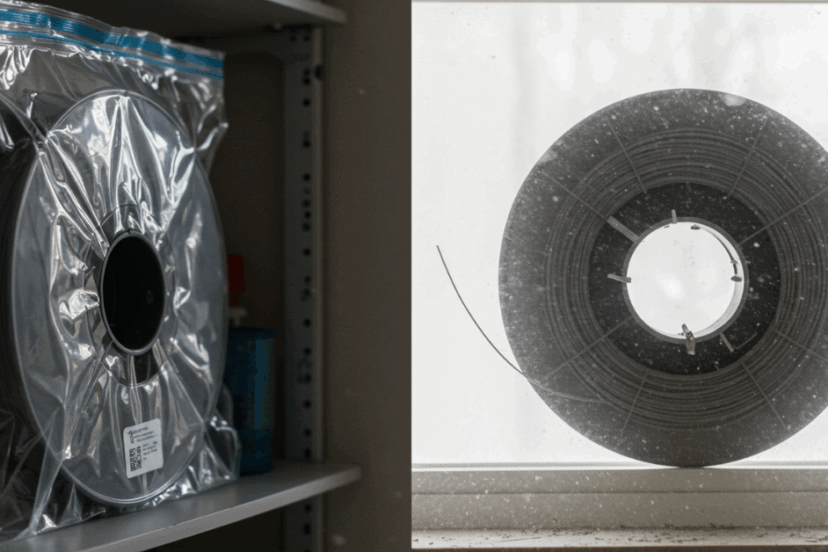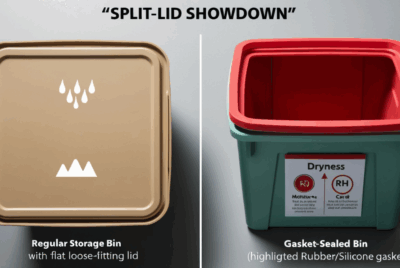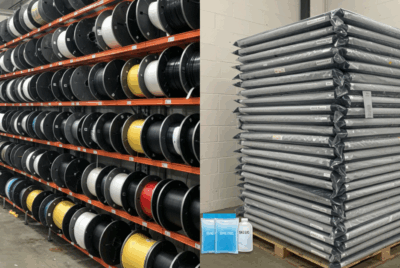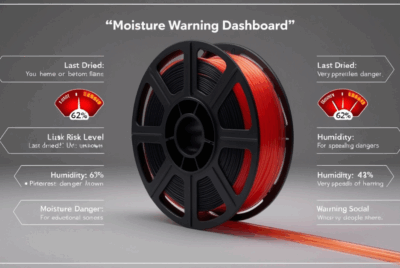How Climate Affects the Longevity of Stored 3D Filament?
1. Why Climate Isn’t Just About Comfort
We usually think of weather as something that affects our mood, commute, or wardrobe. But if you’re into 3D printing, your climate can also mess with your filament.
And not in a fun “sun’s out, prints out” kind of way.
Let’s break down what storing filament looks like in different environments—and how to keep your spools in perfect shape no matter where you are.
2. What Happens to Filament in Humid Climates
Humidity is the arch-nemesis of most 3D filaments.
Moist air seeps into exposed spools, and materials like Nylon, TPU, and PETG soak it up like sponges. This can cause:
- Swollen or sticky filament
- Bubbling or hissing during prints
- Brittle layers and poor adhesion
In tropical zones or rainy regions, filament can go bad in days without proper storage.
3. The Hidden Dangers of High Temperatures
Hot environments—like attics, sunlit rooms, or non-air-conditioned garages—accelerate filament degradation. Here’s why:
- Softening: PLA starts to deform around 60°C (~140°F).
- Breakdown: UV rays and heat break down the polymer chains.
- Moisture diffusion: Heat speeds up moisture absorption.
In hotter climates, always store filament in cool, shaded areas, ideally below 25°C (77°F).
4. Cold Weather & Filament: Friend or Foe?
Cold itself isn’t the enemy. But rapid cold can make some filaments brittle.
Key concerns in freezing climates:
- Condensation when moving spools between cold and warm rooms
- Increased brittleness in PLA and ABS
- Difficulty feeding filament if left in cold garages
TL;DR: Cold storage is fine if it’s dry and stable. But avoid sudden temp shifts.
5. The Trouble with Temperature Swings
Frequent temperature fluctuations are just as bad as extreme weather.
Why? Because they cause:
- Condensation inside storage containers
- Micro-cracking in some filament materials
- Silica gel exhaustion from constantly fighting humidity shifts
If your climate has big day/night differences, insulate your filament storage and use hygrometers.
6. Filament Storage: Indoor vs. Garage vs. Basement
Let’s compare common places people store their filament:
| Location | Risk Level | Why it Matters |
|---|---|---|
| Climate-controlled room | ✅ Low | Best for stable temperature and humidity |
| Basement | ⚠️ Medium | Can be cool but often damp |
| Garage | ❌ High | Hot in summer, cold in winter, high moisture risk |
| Attic | ❌ High | Prone to heat, UV, and no airflow |
7. How Long Does Filament Last in Tropical vs. Dry Climates?
Assuming filament is not stored properly:
| Climate | Estimated Shelf Life |
|---|---|
| Tropical (humid, hot) | ~2–4 months |
| Arid/Dry (desert, high altitude) | 1–2 years |
| Coastal | 4–6 months |
| Temperate (indoor controlled) | 2+ years |
💡 Storage is everything. The same PLA spool may last 2 months in Hawaii and 2 years in Arizona.
8. Most Vulnerable Filaments by Climate Type
| Filament | High Humidity Risk | Heat Risk | Cold Risk |
|---|---|---|---|
| PLA | Moderate | High | Moderate |
| ABS | Moderate | High | Moderate |
| PETG | High | Moderate | Low |
| Nylon | Very High | High | Low |
| TPU | High | Moderate | Low |
9. Regional Tips: How to Store Filament by Environment
- 🌴 Tropical/Humid Regions
- Use vacuum-sealed bags + silica gel
- Store in airtight containers with digital hygrometers
- Consider a filament drying box for regular use
- ❄️ Cold/Freezing Regions
- Let spools acclimate to room temp before printing
- Use insulated bins if storing in cold basements
- Avoid quick transitions from cold to warm
- 🔥 Hot/Dry Regions
- Avoid direct sun exposure
- Store in dark, ventilated closets
- Rotate filament usage to prevent long-term heat damage
10. Tools to Stabilize Filament in Any Climate
Here are some must-haves for climate protection:
- eSUN eBox Lite – great for drying and heating
- PrintDry Pro – ideal for high-humidity regions
- Digital hygrometers – monitor relative humidity
- Silica gel packs – always have them on hand
- Vacuum sealers – perfect for long-term storage
11. Portable Storage Hacks for Makers on the Move
Traveling with filament? Try this:
- Use Ziploc-style vacuum bags with a manual pump
- Toss in a few silica packets
- Carry a compact humidity sensor
- Avoid placing filament in hot cars or direct sun
12. Can Climate-Controlled Storage Improve Print Quality?
Yes, and here’s how:
- Stable storage = predictable extrusion
- Reduced popping or stringing
- Nozzle stays cleaner longer
- Better layer adhesion
- Consistent color and finish
If you print frequently, a dedicated dry cabinet or sealed shelf setup can dramatically improve consistency.
13. What Humidity Levels Are Considered “Safe”?
| Filament Type | Recommended RH |
|---|---|
| PLA, ABS | < 40% |
| PETG, TPU | < 30% |
| Nylon, PVA | < 20% |
Pro tip: Lower is always better—especially if you don’t use the filament daily.
14. How to Monitor and Adjust Your Storage Setup
- Monitor:
- Place mini hygrometers inside storage bins
- Track with an app if you’re using a smart system
- Adjust:
- Add or recharge silica gel
- Seal better (tape lid seams or upgrade bins)
- Move storage away from windows or vents
15. Final Thoughts: Your Filament Has Feelings Too
Your filament may not talk, but it’s definitely sensitive.
It cares whether you live in Seattle, Phoenix, or Iceland—and it’ll let you know if it’s not happy (through bad prints and clogged nozzles 😅).
So treat it like the delicate plastic diva it is. Store it smart, monitor it often, and it’ll give you beautiful prints every time.
❓FAQs
- Can I leave filament out overnight if I live in a dry climate?
Yes, but don’t make a habit of it. Even dry climates have nighttime humidity swings. - Should I store filament in the fridge or freezer?
Nope! Fridges are humid, and freezing risks condensation and cracking. - Is a closet a good place to store filament?
Yes—closets tend to be dark, dry, and temperature stable. - Do I need different storage methods for different seasons?
If your indoor climate changes drastically by season, yes. Consider year-round storage solutions. - What’s the quickest way to lower humidity in my storage bin?
Add fresh silica gel or a small dehumidifier pack designed for containers.




